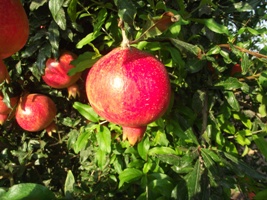Tips for Growing Pomegranates Successfully

Is it worth growing pomegranates in your backyard or garden? Absolutely! Pomegranate fruit has been making the news for some time now, especially in regards to the health benefits that this amazing fruit delivers to our bodies. Even if you’re not a professional gardener, growing pomegranates is not difficult and is very rewarding, especially once the fruit is ripe enough to pick and eat.
About the Pomegranate
Pomegranates have been mentioned in writings as far back as Biblical times and continue to be written about today (even if it’s for different reasons). This antioxidant-packed fruit is fantastic for eating fresh or for making juice. You can also add the fruit or juice to your favorite recipes to create new and exciting dishes. Once picked, the pomegranate fruit will keep well out of the refrigerator for up to 2 months, so it’s perfect for decorating your holiday table or sideboard.
Tips for Growing Pomegranates
Location - These plants love sunlight, so the best place to plant them is where they’ll be able to soak up plenty of sun. Pomegranate plants can grow in partial shade, but if you want the plant to reach its full potential, be sure to plant it in full sun. They’re a hardy plant, so they can withstand harsh weather conditions on both ends of the temperature spectrum.
In most areas of the world, the pomegranate tree leaves are deciduous, but if you reside in much warmer climate, the leaves may be evergreen.
Soil - The soil in which pomegranates grow can vary greatly, so whether you have acidic soil or alkaline soil, these plants will find a way to not only survive, but also actually thrive. It’s as if the plant takes the very best it can find from the soil to help itself grow.
Fertilizer - As hardy as these plants can be, it’s a wise decision to put down some fertilizer into the soil when you plant your pomegranate tree or bush, just to give it a good start. For new plants, it’s recommended that you fertilize the plants twice a year for the first two years (November and March).
Watering – pomegranate plants are resistant to drought and dry conditions and can still do very well without a lot of water. However, during the hotter months of the year, it’s a good idea to water or irrigate the plants regularly.
Harvest – typically in the early fall with most varieties. You’ll know the fruit is ready to harvest when it turns color (red, purple, white, green, or pink). Another way to tell if it is at the peak of ripeness is to tap the fruit with your fingertip. If it makes a “metallic” sound, it’s ripe and ready to pick!
Flowers – the flowers have been known to draw hummingbirds, making the area surrounding your pomegranate tree a flurry of activity during the warmer months of the year. The tube-shaped flowers are a favorite of many gardeners and are a great draw for birds of all kinds.
Read enough about growing pomegranates and want to discover more about the pomegranate tree?
Amazing Pomegranate Health Benefits







